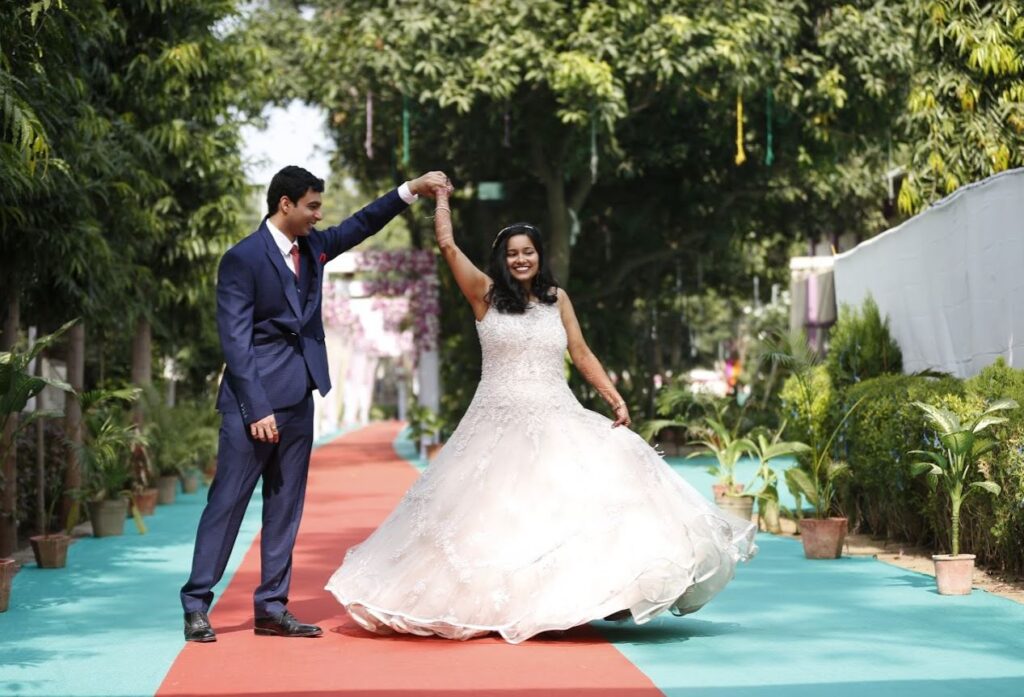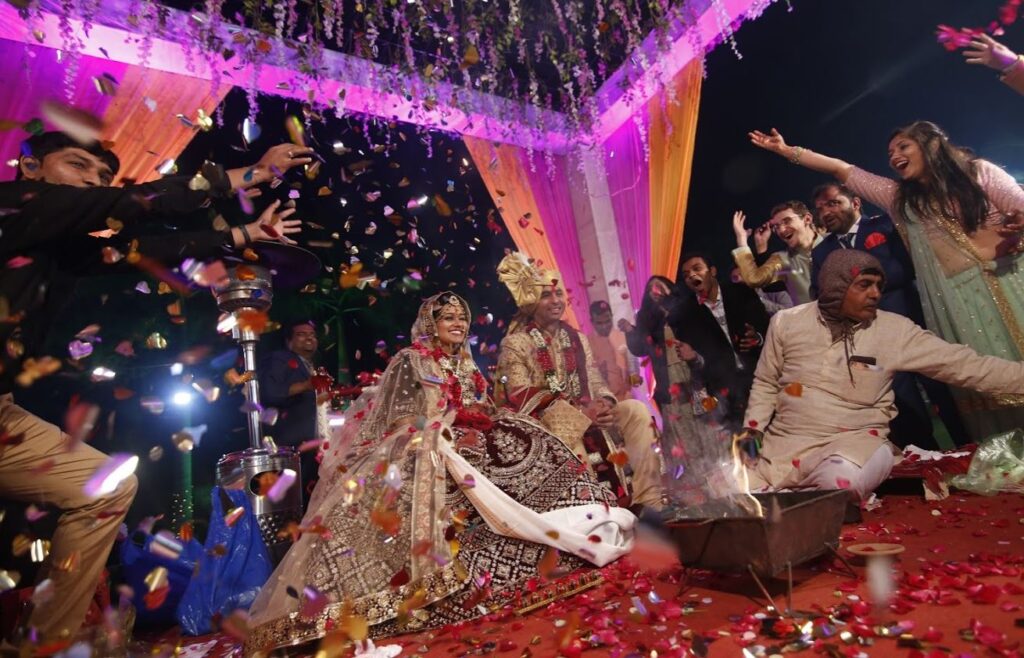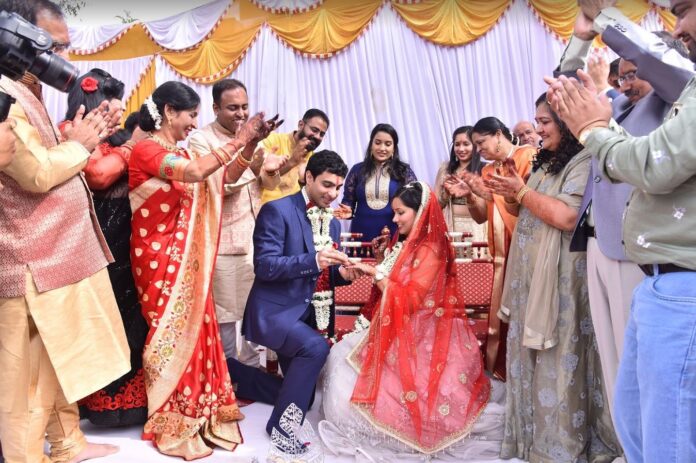By Shruti Rajkumar, AsAmNews Intern
Indian American Divyesh Jani, 32, remembers his parents telling him that marriage is one of the most important decisions that a family—rather than just him alone—has to make, and that he should get along with his spouse and her family.
“[My parents] would tell me that when you decide to get married, it won’t just be about the two of you but about two families, so I wouldn’t be as happy as I can be if I didn’t get along with her family,” Jani said.
According to a newly released report from the Carnegie Endowment for International Peace, Indian Americans exhibit very high rates of marriage within their community. The study found that eight out of 10 respondents have a spouse or partner of Indian origin.
Marriage and family therapist Pooja Mamidanna, 30, said that within traditional Indian culture, marriage is seen as holy matrimony and the blending of two families. Indians primarily only want to get married once to someone from their own ethnic and cultural backgrounds, and aren’t open to intercaste, interracial, and interreligious marriage.
While the older generation of Indian Americans tend to hold more of these traditional, orthodox perceptions of marriage and divorce, the younger generations have developed more progressive views.
Mamidanna said that these statistics may have to do with acculturation, as the present generation is more inclined to find a spouse who has a blend of Indian and American culture and identity. Since the Indian Americans who were born and raised here were exposed to different and societal ways than those in India, she notes that many also want that for their own families and future spouses.
“They really can tell the [traditional Orthodox] patterns that exist within their family system, and some of them want to advocate to live a life for themselves where they’re able to be independent when they want to be, but then [are] also able to have that family support,” Mamidanna said.
Jani is among the 80% of Indian Americans with a spouse of Indian origin, and has been married to his wife, Riddhi Thaker, for 18 months. For him personally, he wanted to marry someone of Indian origin, and believes that the similarity in cultural background is why Indian Americans might want to find partners from within their community.

“I personally wanted to marry someone of Indian origin because when I came to the U.S. at the age of 25, I already knew I will enjoy more being with a partner who has and appreciates similar family values, music, food, movies, and sports, and these things were difficult if not impossible to get from someone who isn’t Indian,” said Jani.
The Carnegie Endowment for International Peace study also found that the U.S.-born Indian Americans are four times more likely to have a spouse or partner who is of Indian origin and also born in the United States. Pooja Mamidanna’s father, first generation Indian immigrant Prasad Mamidanna, 62, said that this may be due to the growing Indian diaspora.
“It may have more to do with the added burden of visas and delays related to getting married to a spouse in India. With the growing local Indian origin diaspora, there is now an option which was not feasible to us in our generation,” he said.
Pooja Mamidanna said that the younger generation of Indian Americans also seem to be more open to interracial and interreligious marriage. Her father said that the ultimate decision of who to marry should be left up to the couple, however he believes that there are challenges that come with interracial marriages.
“It takes a lot of effort, sacrifice, and patience to make an interracial marriage work. Over time, many flashpoints will flare up which can be challenging unless the families have a very open, transparent, and flexible attitude,” he said.
Mamidanna recalls that while growing up in India, most of the marriages at the time were arranged and occurred within family and friend connections.
“Considerable effort was made to screen possible pitfalls and warning signs relating to the family background, [and] there was little or zero interaction between the bride and the groom,” he said. [The] focus was on the family, the economics and credibility.”
Pooja Mamidanna said that in the current day and age, Indian Americans have more of a say in arranged marriages. She compares the process to how online dating operates, in which families look for matches, and the two people go on dates to determine if it’s a good match.
“I don’t feel like there’s a pressure to commit more so than how it used to be in the past. But it depends on the family system, because [in some], your family just has the say and you kind of have to go with it,” she said.
When she was in her 20’s, her family wanted her to explore the arranged marriage route. She didn’t end up getting married through the process, though, because of the negative perceptions of divorce in Indian culture. Her parents had gotten a divorce when she was second grade, and she recalls facing a lot of stigma from boys and their families in the arranged marriage process because of it.
“[They were] not okay with the girl coming from a broken family [and] divorce being present. [I faced] statements like, ‘We’re afraid that you’re going to be like your mother,’ and “Our family is not used to dynamics like that.’ Through that experience, I just realized…even people who are born and raised here still hold on to these stereotypical mindsets,” the marriage and family therapist said.
Divorce is never discussed in traditional Indian culture, she continued. Across all generations, she said there’s a pattern of staying in unhappy marriages to please the family, as well as out of worry as to how they would support themselves and their children if a separation were to happen.
Although her father’s personal perceptions of marriage, divorce, and re-marriage have evolved and refined over the years, he said that ultimately they haven’t changed. When he was growing up, divorce was never an option. Issues within a marriage needed to be worked out, often with the help of families.
“You should always be who you are and your actions [and] decisions should be within your moral compass. I was given a written code of conduct by my father when I left India, and to this day I try my best to live within those guiding principles. In essence, it was about blending and imbibing the best values of Indian and American cultures,” said Mamidanna.
With her South Asian clients, Pooja Mamidanna has noticed that younger generations want to advocate for themselves more through family therapy or divorce, even if they receive backlash against their family for it.
“Within Indian culture, we are never taught how to put ourselves first, especially women. So the majority of the therapy is about teaching them it’s not selfish to put themselves first, and then working through that guilt and fear piece,” she said.

Divorce was never brought up in Jani’s family, as there was an assumption that they would never need to. He’s unfamiliar with how his parents perceive divorce, other than that it looks bad in society.
“I believe divorce is the right thing to do when two people involved aren’t happy in the marriage and the differences are beyond solvable. But a divorce should be the absolute last option, so [one should] put all the effort in finding the right person in the first place,” Jani said.
Based on what she has seen and observed from South Asian clients, Pooja Mamidanna believes that some traditional Indian perceptions of marriage and divorce have stayed the same for younger generations, while others have changed and are decreasing.
“I feel like it’s changing because of acculturation and the younger generation not wanting to marry young. They first want to make a career, work, and then they think about marriage, [and they also] really focus on equal division of labor in a marriage. They both want to be breadwinners in a marriage, and the traditional patriarchy does not really exist,” she said.
AsAmNews has Asian America in its heart. We’re an all-volunteer effort of dedicated staff and interns. Check out our new Instagram account. Go to our Twitter feed and Facebook page for more content. Please consider interning, joining our staff, or submitting a story or making a contribution.



It would be nice if we could get a breakdown on who we are marrying if not another indian(mostly to sate my own personal curiosity). How does that 21% break down, especially among the american-born Indians who are nearly twice as likely to marry a non-indian.
Are we marrying whites, hispanics, blacks, east asians or other SE asians? The ones marrying foreigners – where are they from?
Still, very good data.